One of my favorite things about living in Guatemala is the farmer’s markets. These bustling centers of commerce are a veggie lover’s dream. Women in traditional Mayan clothing sell mounds of bright orange carrots, edible flowers, starchy tubers, and piles of fluffy spinach. Guatemala has so much more to offer than many people’s standard potato-onion-tomato lineup. Don’t miss out on the delicious flavors and textures offered by these 7 unusual Guatemalan vegetables.
I’m super excited to collaborate with Chef Kassia Emily Fiedor on this post. She’s allowed me to include four recipes from her amazing Guatemalan fusion Cocina Holistica Cookbook. I’ll talk more about the cookbook and Chef Kassia later in this post, but in the meantime, let’s dive in!
Table of Contents
Güisquil
Recipe: Guatemalan Güisquil Chilaquilas
Güicoy
Inchintal
Recipe: Inchintal Güicoyito Soup from Cocina Holistica
Tamarillo
Recipe: Tamarillo Amaranth Crumble from Cocina Holistica
Loroco
Recipe: Arugula Camote Salad w/ Loroco Ranch Dressing from Cocina Holistica
Macuy
Recipe: Basil-Macuy Vegan Pesto from Cocina Holistica
Pacaya
Recipe: Pacaya en Huevo
Cocina Holistica Cookbook
About Chef Kassia Emily Fiedor
Conclusion
Güisquil
Güisquil (sechulum edule) is a delicious and unusual Guatemalan vegetable you can’t go without tasting. It is a type of squash that grows on a climbing vine common throughout Guatemala. In fact, it’s one of Guatemala’s most-used vegetables. It has a mild flavor, lighter and greener than a potato.
You’ll come across it in soup, Guatemalan Chao mein, and chilaquilas (yum). Güisquil can have dark green or pale yellow skin, but the yellow-skinned variety is usually called “peruleros.” Güisquiles can be either spiky or smooth. In general, the spiky criollo varieties are firmer and richer in flavor. I recommend boiling the spiky ones whole and eating them as a side dish. However, if you need to slice or chop the vegetable ahead of time, get the smooth-skinned varieties and save your fingers some pain.
Güisquil vines and seeds are also edible. The tender vine tips, sold as “puntas de güisquil”, are a nice addition to soups. The seeds are very tasty. Simply pluck them from the center of the cooked vegetable and enjoy. The seeds have a deep starchy flavor which I love.
Tip: Some people get a skin reaction from cutting raw güisquil. Feel free to buy pre-cut güisquil in the market, or simply put on gloves before peeling and slicing.
Guatemalan Güisquil Chilaquilas
2 large güisquils (smooth-skin variety)
“Queso Fresco” Farmer’s cheese or “Queso de Capas”
1 large onion, diced
1-2 tomatoes, diced
3 eggs
salt
Preparing Chilaquilas
Wash and peel the güisquils, then slice them into quarter-inch rounds. Boil until just tender, then remove and pat dry.
Sauté the tomatoes and onions, then set aside.
Slice the cheese into quarter-inch slices.
Separate the egg yolks and whites. Beat the whites until soft peaks form, then fold in the yolks and salt.
Heat a cast-iron skillet with a generous amount of olive oil.
To assemble, make a sandwich with two slices of güisquil filled with a slice of cheese and some of the tomato and onion mixture. Carefully coat the “sandwich” in the egg mixture, then fry it in the olive oil until golden brown, turning once.
If desired, top with a simple tomato sauce and/or “queso seco” before serving.
Güicoy
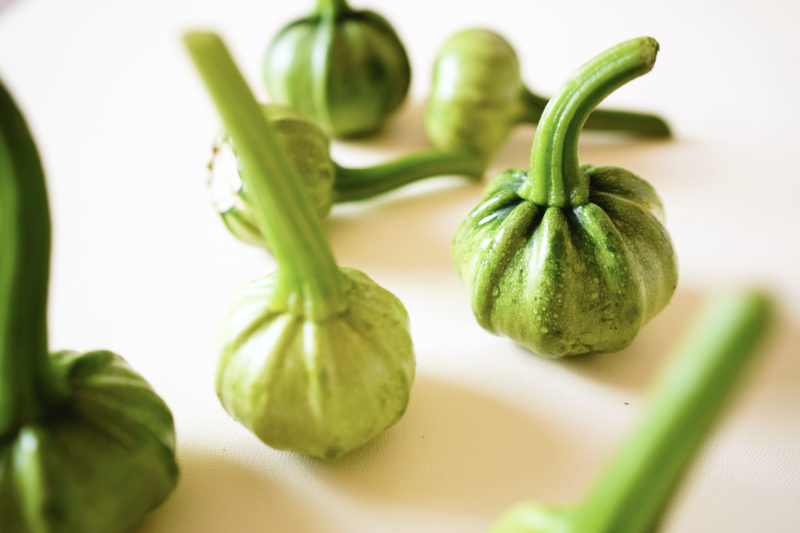
Güicoy is a delicious squash that grows throughout Guatemala. The small tender “güicoyitos” are a great native alternative to zucchini. If güicoyitos are left on the vine until the skin turns dark green or orange and the skin thickens, they become a lovely winter-style squash known as “güicoy sasón”.
The bright yellow flowers of the güicoy vine are also edible. I love to add them to scrambled eggs, soups, stir-fries, and salads.
If you have any garden space and want to plant some native vegetables, güicoy is a great choice! You can start off by eating the male flowers (they have a single pollen-laden pistil in the center), then eat the young güicoyitos. Leave a few on the vine to mature and enjoy as boiled or roasted güicoy sasón.
Check out Chef Kassia’s Inchintal Guicoyito Soup below.
Ichintal
The root of the güisquil vine deserves its own entry. Known as ichintal or inchintal, this fabulous tuber is considered a delicacy. It is only available during particular times of the year (for example, in September). Keep an eye out for them, and be sure to buy them when you get a chance. I love them boiled, sliced, and fried until golden. You can also shred and fry them for a grain-free sushi-rice alternative or a less-traditional hash brown.
And of course, eating them in Chef Kassia’s creamy healing soup could be the best way of all!
Ichintal Güicoyito Soup from Cocina Holistica
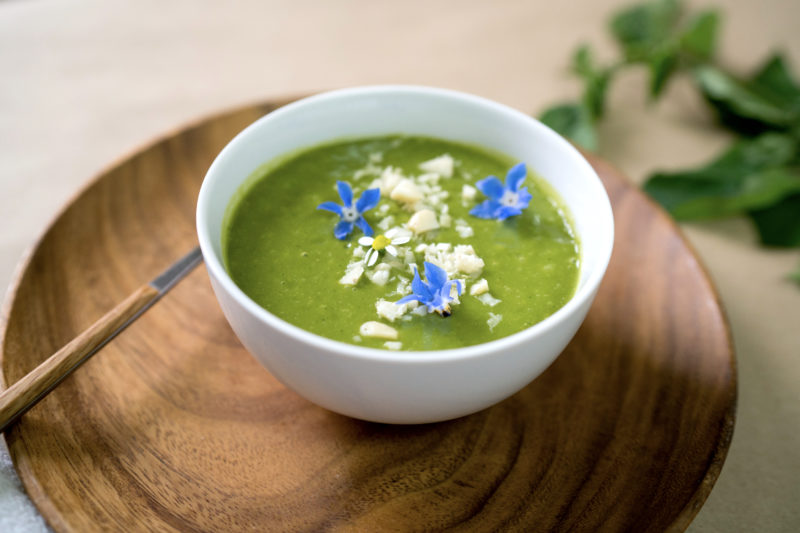
Serves 4
A note from Chef Kassia Emily Fiedor
This green soup features three main ingredients that have deep ancestral roots in Guatemala – guicoyitos, ichintal, and macuy. Ichintal, the root of the chayote or güisquil plant, was a staple in Pre-Colonial diets and is said to control high blood pressure. Considered a delicacy, ichintal is incredibly rich and soft when cooked, resembling the texture of a potato, and lends a nice creaminess to the soup. Native macuy leaves are rich in iron, protein, and phosphorus and contain anti-fungal compounds helpful for skin conditions. Guicoyitos are cute Mayan heirloom squash that look and taste like round zucchini.
Sip this soup and travel back in time to the ancient civilizations of Mesoamerica.
Ingredients
2 tablespoons coconut oil
1 onion, chopped
3 garlic cloves, chopped
2 celery stalks, chopped
2 cups guicoyitos, cubed
1 teaspoon ground cumin
1 cup ichintal, cubed
3 cups vegetable broth, chicken broth, or water
1 cup macuy, rough chopped
1 teaspoon sea salt
Juice of 1⁄2 lemon
Preparation
In a large stock pot, heat the oil on low heat, then add the onion and celery and a teaspoon of salt. Allow the onions and celery to simmer, stirring occasionally. They should be simmering slowly, but not burning.
Once they have started browning (this gives a lot of flavor), add the garlic, guicoyitos, and cumin, and stir about 2 minutes.
Add the ichintal root and the broth or water. Bring to a boil, then lower the heat, and simmer uncovered about 15 minutes, until the veggies have softened.
Turn off the heat, then add the macuy, allowing it to wilt a few minutes.
Add everything plus the lemon juice to a high-speed blender, and blend until smooth. Adjust the flavors – add more salt, lemon juice, or cumin to your liking.
Substitutions:
Guicoyitos – zucchini
Ichintal – potato or cauliflower
Macuy – watercress or spinach
Tamarillo (Tomate de Arbol)
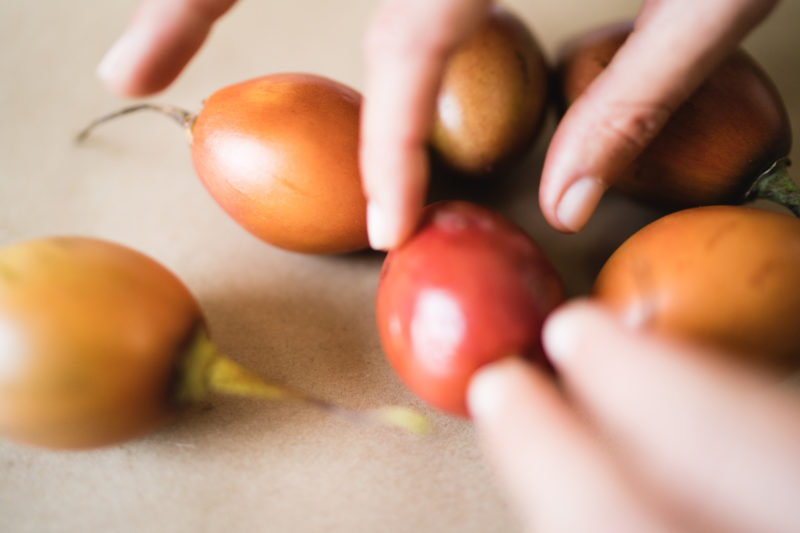
Tamarillo, or tree tomato (Cyphomandra betacea) is another unusual Guatemalan vegetable. It grows especially well in Coban Guatemala and has a delicious tangy-sweet flavor. The skin is bitter, so it’s best to peel them before eating. Tamarillos are great in chutney, sweet and sour sauces, sliced in sandwiches, or in Chef Kassia’s scrumptious fruit crumble (below).
Eating tamarillos can help lower blood pressure and boost your metabolism. The takeaway: you don’t need to feel guilty when eating this dessert!
Tamarillo-Amaranth Crumble from Cocina Holistica

Photography © by Mono del Espacio, used with permission from Veriditas Publishing
Serves 6
A note from Chef Kassia Emily Fiedor
Otherwise known as tree tomato or tamarillo, “tomates de arbol” are one my favorite fruits in Guatemala. Native to Central and South America, they are mostly found in home gardens and backyards, and surprisingly they’re grown commercially in New Zealand. They’re in the Nightshade family, related to tomatoes and eggplants. High in vitamins A, C, E, and B6, as well as fiber, this fruit is tangy and sweet, making it perfect for a crumble. To easily peel off the bitter skin, score an X into the tip of each tomate de arbol with a knife. Simmer in water for 10 minutes, then peel. This would be a nice low-sugar dessert, breakfast, or snack.
Crust:
1 1/2 cups rolled oats
1 cup pecans
3 tablespoons coconut oil
1 egg
3 tablespoons honey
1⁄4 teaspoon salt
Filling:
10 tomates de arbol, peeled
1⁄2 cup dates, soaked in hot water 20 minutes
1 tablespoon chia seeds
pinch of salt
Crumble:
1 cup amaranth flour
1⁄2 cup oats
1/3 cup shredded coconut
1⁄4 cup honey or maple syrup
1 teaspoon cinnamon
1 teaspoon cardamom
1 teaspoon dried ginger
4 tablespoons (half stick) butter, cold, and cut into small squares
1⁄4 teaspoon salt
Preparation
Preheat oven to 350 ̊F.
In a food processor, blend oats and pecans until you have a rough flour. Add coconut oil, egg, honey, and salt. Pulse until you have the texture of dough.
Place the dough into a lightly greased 8”x8” brownie pan and press firmly. It helps to wet your hands so that the dough doesn’t stick. Place in the oven for 20 minutes.
To make the filling, place the tomates de arbol, dates, and salt in a blender and blend until smooth. Add the chia seeds at the last minute, and pulse quickly to combine.
Remove the crust from the oven and spread all of the filling over it.
In a medium bowl, mix the ingredients for the crumble, using your fingers to incorporate the butter.
Sprinkle the crumble topping over the layer of filling.
Place in the oven for 15 minutes, until slightly golden on top.
Let cool completely before cutting into bars.
Serve with coconut cream, vanilla ice cream, or coconut butter if desired.
Store in the fridge for up to five days.
Loroco
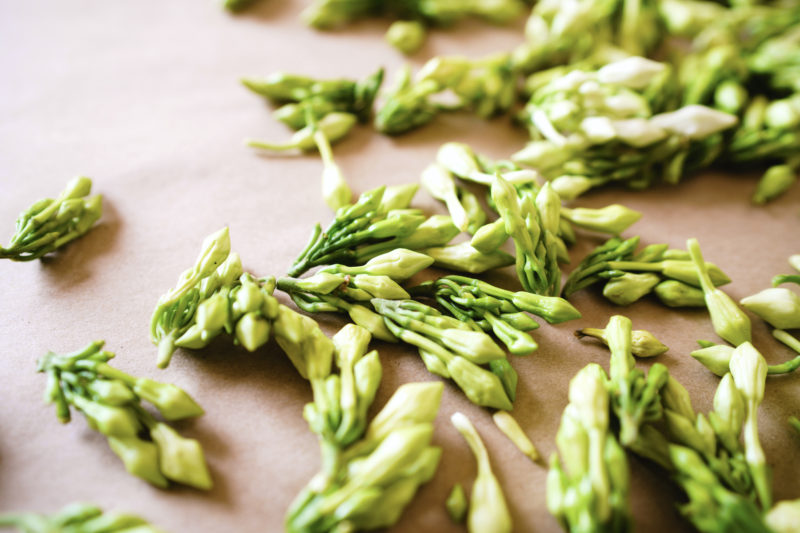
Loroco (Fernaldia pandurata) is a tropical vine with delicious pungent buds. Loroco flower buds are mild antioxidants, rich in fiber, calcium, and vitamin C. The vines grow throughout Central America. Loroco buds are a common ingredient in El Salvador’s tasty pupusas. They are also a yummy addition to scrambled eggs or added to stir-fries.
Arugula Camote Salad w/ Loroco Ranch Dressing from Cocina Holistica
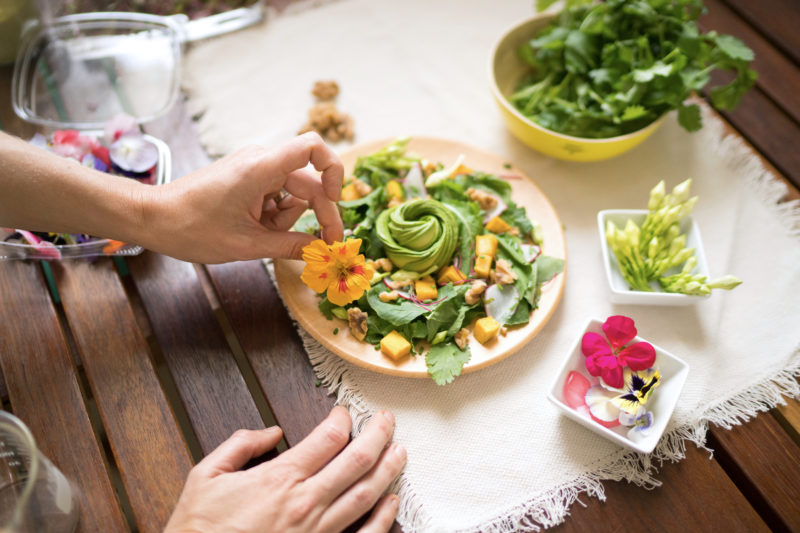
Serves 3-4
A note from Chef Kassia Emily Fiedor
You may be familiar with loroco flowers if you’ve ever eaten Pupusas, the famous El Salvadorian specialty. These small, tightly closed buds appear in the markets in Guatemala around July for just a few months, and have a very unique flavor profile. Earthy and herbaceous, loroco also tastes slightly nutty, which inspired me to use it as a base for a vegan ranch dressing – and it’s amazing. Sweet camote and spicy arugula complement the intensity of the dressing, while radishes add a nice crunch. Both fresh avocado and it’s oil provide healthy fats, creating a well-balanced and colorful salad with a fun Guatemalan twist!
2 medium camote or sweet potato, chopped into 1⁄2 inch cubes
1 tablespoon coconut oil
4 cups baby arugula
3 radishes, sliced thinly
1⁄4 cup raw walnuts, rough chopped
1⁄2 avocado, sliced
Amaranth sprouts for garnish
Loroco flowers for garnish
Loroco Ranch Dressing
1 1⁄2 cups loroco flowers, rinsed
2 tablespoons lemon juice
1 1/2 tablespoons dried dill
1 1/2 teaspoons garlic powder
1 1/2 teaspoons onion powder
1⁄4 cup avocado oil
1⁄2 cup water
1⁄2 teaspoon mustard (grainy)
1 1/2 teaspoons sea salt
In a large skillet heat 1 tablespoon coconut oil on medium heat. Sauté camote plus a few pinches of salt until tender. Set aside.
Meanwhile, in a high-speed blender, blend all ingredients for the dressing until smooth. Taste and add more salt or lemon if desired.
In a large serving bowl, combine the arugula, radishes, walnuts, avocado, and camote or sweet potatoes.
Toss with an adequate amount of dressing.
Garnish with amaranth sprouts and more loroco flowers to serve.
Macuy
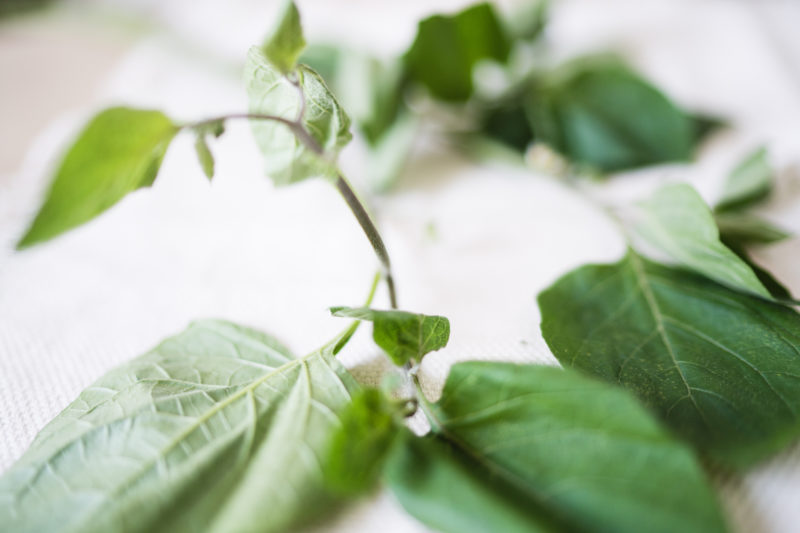
Macuy (solanum americanum), also known as quilete or hierba mora is a wild herb that grows throughout the Americas. Macuy is great added to soups, packed inside whole roasted fish, or turned into creamy pesto. Discover more about macuy in the recipe description below.
The leaves and flowers of macuy are edible, but the berries are poisonous. Remove them before cooking!
Basil-Macuy Vegan Pesto from Cocina Holista

Makes about 1 1/2 cups
A note from Chef Kassia Emily Fiedor
You won’t believe this pesto does not have cheese in it! Everyone who tries it is shocked – it’s simple, chock full of healing greens and healthy fats, and it honestly passes for the real thing. Macuy is a native Mayan superfood bursting with nutrition. Sometimes called quilete, a name many Guatemalans use to refer to any weed, it is found in every market and often seen in backyards and country roads. It has a delicate vegetal flavor that compliments the basil well in this pesto. I love using the potent and spicy Guatemalan basil “albahaca morada.” I usually choose omega-3 packed walnuts for their soft texture and earthy flavor, but feel free to substitute your favorite nut here. This is the most versatile sauce – serve it with zucchini noodles, roasted veggies, over eggs, on sourdough toast, on pizza or baked potatoes, or as a dip for crudités. The possibilities are endless!
Ingredients and Preparation:
1 1/2 cups macuy, packed*
1 cup basil, packed
1⁄2 cup olive oil
2/3 cup walnuts
2 garlic cloves
3 tablespoons lemon juice
1⁄2 tablespoon salt
In a food processor, combine all the ingredients and process until well combined. I like to keep it a bit chunky.
Store in an airtight container for up to a week.
*If you can’t find macuy, you can substitute any green – spinach, arugula, kale, amaranth leaves, chard, etc.
Pacaya
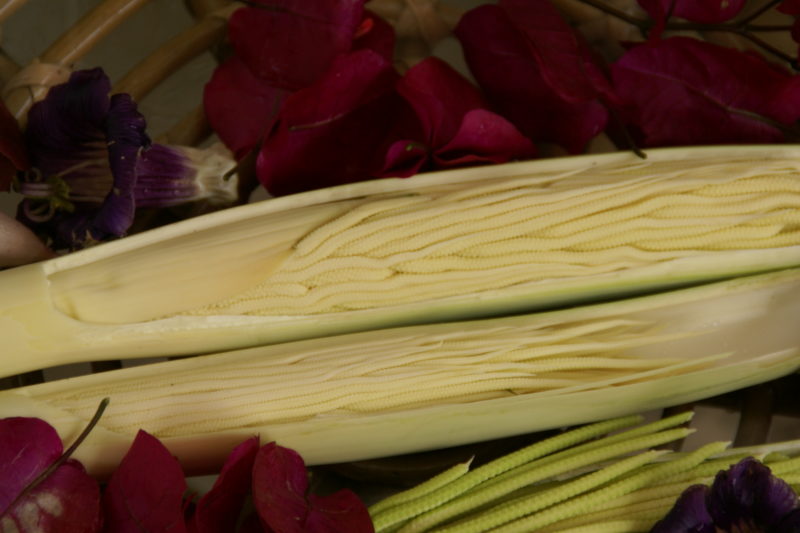
Pacaya is one of the most unusual Guatemalan vegetables on this list. Pacaya refers to the male flowers (also called inflorescence) of the pacaya palm (chamaedorea tepejilote). In the market, they are sold inside their green sheaths, which look like narrow pointy ears of corn. Inside are long white strings made up of hexagonal sections. Pacaya is rich in vitamins and minerals, and also has cough-relieving properties.
Since pacaya is bitter, it is best to blanch it. One of my friends recommends blanching it three times in fresh boiling water to eliminate more of the bitter flavor.
Pacaya is delicious pickled and added to “Fiambre” — a traditional cold salad eaten on the Day of the Dead in Guatemala. It is also commonly covered in beaten egg and fried.
Pacaya Volcano gets its name from this eponymous vegetable, which grows in abundance on Pacaya’s slopes.
Pacaya en Huevo (Pacaya in Egg)
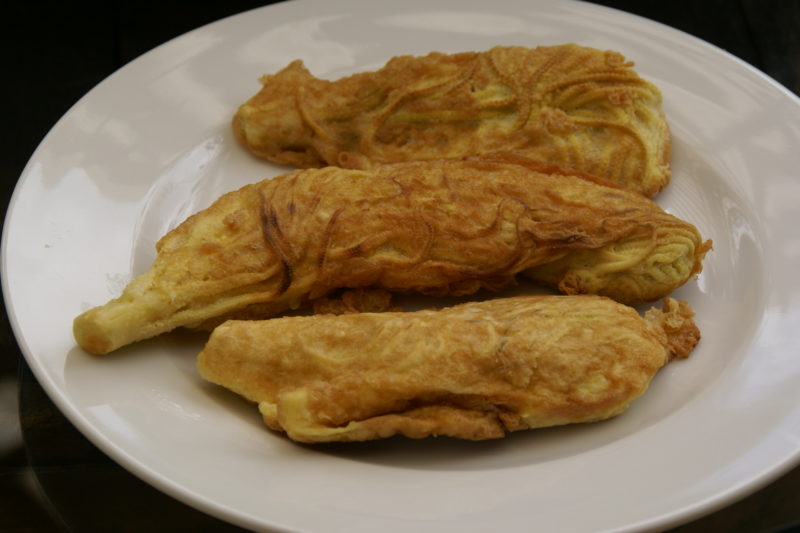
4 tender pacaya sheaths
2 eggs
2 T flour
salt
Preparing the pacaya
Remove the sheath from around the strings of pacaya. Try to keep the pacaya strings attached by the stem so they stay clumped together. Plunge into salted boiling water and allow to boil for 2-3 minutes. Drain, then repeat twice more. Use fresh salted water each time.
Drain the pacaya and pat dry.
Separate the egg yolks from the whites. Beat the egg whites until soft peaks form. Gently fold in the egg yolks, one teaspoon of salt (or to taste), and two tablespoons of flour.
Heat a cast-iron skillet, then add a generous amount of olive oil.
Once the olive oil is hot, but not smoking, take one clump of pacaya and drag it through the egg mixture until it is generously coated. Fry until golden brown, turning once.
Top with homemade tomato sauce.
Preparing the tomato sauce
To make tomato sauce: Roast tomatoes in a cast iron griddle until the skin blackens and splits. Blend or crush with a potato masher. Pour the mixture through a strainer, then add salt to taste.
Cocina Holistica Cookbook
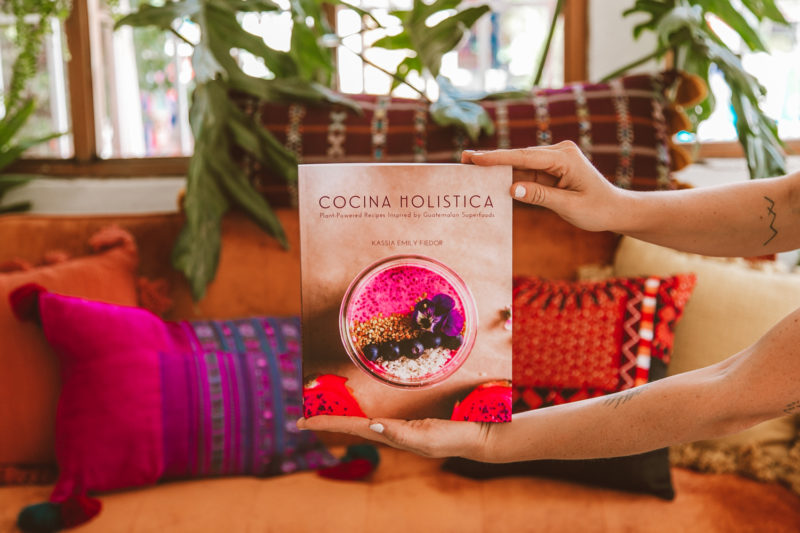
I’m a big fan Chef Kassia’s Cocina Holistica cookbook. If you want to make more recipes featuring Guatemalan superfoods, you’ll love her cookbook. My favorite recipes from the book include the warming spicy goodness of her Camote Carrot Ginger Soup, the rich flavors of her fabulous Chipilín Shakshuka, and the refreshing flavor pop in her Green Mango Spring rolls. And that’s only to mention a few.
More about Cocina Holistica
“In her debut cookbook Cocina Holistica, Kassia infuses ancestral ingredients into healing plant-based dishes. Drawing upon the magnificent beauty of Guatemala, she hopes to inspire renewed respect for indigenous plants in creative, modern recipes. All recipes are gluten-free, dairy-free, and sugar-free, with a focus on nutrient density. Find it on Amazon, or directly from Kassia on her Instagram @infusedholistickitchen.”
About Chef Kassia Emily Fiedor

“Kassia Emily Fiedor is a Holistic Nutritionist, Herbalist, and Wellness Chef from Southern California, currently based in Nashville. Passionate about using plants, herbs, & vegetables as medicine, she encourages her clients to eat in harmony with their bodies and nature. Kassia lived in Guatemala for 5 years where she taught healthy cooking classes and made nutrient-dense meals for people with an appreciation for nourishing high-vibration food. Amazed by the abundance of native superfoods, she fostered intimate connections with small organic farmers and artisans producing high-quality products. She cooks for spiritual retreats, special gatherings, and gives private cooking classes.”
Learn more at Infused Holistic Kitchen.
Conclusion
Although there are many more unusual Guatemalan vegetables not included in this post, including a variety of herbs, mushrooms, edible flowers, and fruits, this list should get you started. Head to the market, buy the ingredients you need, and get cooking. Flavor bombs await!
Looking for Guatemalan food you don’t have to cook yourself? Check out our Eat Atitlán Guide page!
Find out where to shop for groceries in Panajachel or how to eat like a local in Santiago.
